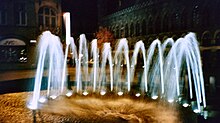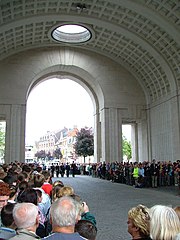| Revision as of 13:14, 23 June 2006 editBurnley Masher (talk | contribs)46 edits →External links← Previous edit | Revision as of 18:05, 23 June 2006 edit undoAndrew Gray (talk | contribs)Edit filter managers, Administrators55,918 editsm Reverted edits by Burnley Masher (talk) to last version by Sijo RipaNext edit → | ||
| Line 1: | Line 1: | ||
| ] | ] | ||
| '''Ypres''' (], pronounced "ēpr", generally used in English<sup><font id="1">]</font></sup>) or '''Ieper''' (official name in the local ], pronounced "YĀ-pər") is a ] located in ], one of the three regions of ], and in the ] province of ]. The municipality comprises the city of Ypres and the towns of ], ], ], ], ], ] and ]. On ] ] Ypres had a total population of 36,120 | '''Ypres''' (], pronounced "ēpr", generally used in English<sup><font id="1">]</font></sup>) or '''Ieper''' (official name in the local ], pronounced "YĀ-pər") is a ] located in ], one of the three regions of ], and in the ] province of ]. The municipality comprises the city of Ypres and the towns of ], ], ], ], ], ] and ]. On ] ] Ypres had a total population of 36,120 | ||
| .The total area is 130.61 ] which gives a ] of 267.58 inhabitants per km². | .The total area is 130.61 ] which gives a ] of 267.58 inhabitants per km². | ||
| Line 51: | Line 51: | ||
| * - Information available in ] and limited information available in ] | * - Information available in ] and limited information available in ] | ||
| * | * | ||
| * | |||
| == Notes == | == Notes == | ||
Revision as of 18:05, 23 June 2006
Ypres (French, pronounced "ēpr", generally used in English) or Ieper (official name in the local Dutch, pronounced "YĀ-pər") is a municipality located in Flanders, one of the three regions of Belgium, and in the Flemish province of West Flanders. The municipality comprises the city of Ypres and the towns of Boezinge, Dikkebus, Elverdinge, Vlamertinge, Voormezele, Zillebeke and Zuidschote. On January 1 2005 Ypres had a total population of 36,120 .The total area is 130.61 km² which gives a population density of 267.58 inhabitants per km².
It is an ancient town, and is known to have been raided by the Romans in the first century BC . During the Middle Ages, Ypres was a prosperous city with a population of 40,000, renowned for its linen trade with England. It was the hometown of William of Ypres, a commander of Flemish mercenaries in England who was reckoned among the more able of the military commanders fighting for King Stephen in his prolonged civil war with the Empress Matilda.
In order to prosper and maintain its wealth, Ypres had to be fortified to keep out invaders. Parts of the early ramparts, dating from 1385, still survive near the Rijselpoort (Lille Gate). The famous Cloth Hall was built in the thirteenth century. During this time also, cats, then the symbol of the devil and witchcraft, were thrown off the cloth hall to get rid of evil demons. Today, this act is commemorated with a triennial Cat Parade through town.
Over time, the earthworks were replaced by sturdier masonry and earthen structures and a partial moat. Ypres was further fortified in 17th and 18th centuries while under the occupation of the Hapsburgs and the French. Major works were completed at the end of the 17th century by the French military engineer Sebastien Le Prestre, Seigneur de Vauban.
During World War I, Ypres was the centre of intense and sustained battles between the German and British Commonwealth forces. The town was all but obliterated by the artillery fire. After the war the town was rebuilt with the main square, including the Cloth Hall and town hall being rebuilt as close to the original designs as possible. (The rest of the rebuilt town is more modern in appearance.) The Cloth Hall is today a museum dedicated to Ypres's role in the First World War.

Ypres these days has the title of "city of peace" and maintains a close friendship with another town on which war had a profound impact: Hiroshima. The association may be regarded as somewhat gruesome due to the fact that both towns witnessed mankind at its worst: Ypres was one of the first places where chemical warfare was employed, while Hiroshima suffered the debut of nuclear warfare.

World War I
Ypres was a key position during World War I because it stood in the path of Germany's planned sweep across the rest of Belgium and into France from the North. The German army formed a salient around the city, bombarding it from nearly all sides throughout much of the war. To counterattack, British, French and allied forces made costly advances from the town of Ypres into the German lines on the surrounding hills.

In the First Battle of Ypres (October 31 to November 22, 1914) the British captured the town from the Germans. In the Second Battle of Ypres (April 22 to May 25, 1915) the Germans used poison gas for the first time on the Western Front (they had used it earlier at the Battle of Bolimow on January 1, 1915) and captured high ground east of the town. The first gas attack occurred against a force of mostly colonial soldiers from French Africa. The gas used was Chlorine gas. Mustard gas, also called Yperite from the name of this city, was also used for the first time near Ypres in the autumn of 1917.
Of the battles, the largest, best-known, and most costly in human suffering was the Third Battle of Ypres (July 21 to November 6, 1917, also known as the Battle of Passchendaele) in which the British, Canadians and ANZAC forces recaptured the Passchendaele ridge east of the city at a terrible cost of lives. After months of fighting, this battle resulted in nearly half a million casualties to all sides, and only several miles of ground won by Allied forces.
English-speaking soldiers in that war often referred to Ypres by the (perhaps humorous) mispronunciation "Wipers". British soldiers even self-published a wartime newspaper called the "Wipers Times."
War graves, both of the Allied side and the Central Powers, cover the landscape around Ypres. The countryside around Ypres is featured in the famous poem by John McCrae, In Flanders Fields.
Menin Gate

The Menin Gate Memorial; in Ypres is dedicated to the soldiers with no known graves who fell on the Ypres Salient during the First World War and whose bodies are still buried on the battlefields around Ypres. The memorial's location is especially poignant as it lies on the eastward route from the town which allied soldiers would have taken towards the fighting - many never to return. Every evening since 1928, traffic around the imposing arches of the Menin Gate Memorial has been stopped while the Last Post is sounded beneath the Gate. This tribute is given in honour of the memory of British Empire soldiers who fought and died there.
The ceremony was prohibited by occupying German forces during the Second World War, but it was resumed on the very evening of liberation — 6 September, 1944 — notwithstanding the heavy fighting that still went on in other parts of the town.
Quotations
- "Who will remember, passing through this Gate,
- The unheroic Dead who fed the guns?"
- -- Siegfried Sassoon, On Passing the Menin Gate
Famous inhabitants
- Jacob Clemens non Papa (ca. 1510-1556), Renaissance composer
- Cornelius Jansen (1585-1638), bishop of Ypres and father of the Jansenism
- Renaat Landuyt (b. 1958), politician, Belgian minister
- Yves Leterme (b. 1960), politician, Flemish minister-president
- Lernout & Hauspie, founders of the infamous speech technology company of the same name
- Jules Malou (1810-1886), politician, Prime Minister of Belgium from 1871 to 1878 and in 1884
External links
- Official website - Information available in Dutch and limited information available in English
- In Flanders Fields Museum
Notes
Footnote
The Flemish language was restricted by the French-speaking Belgian ruling class at the time of the First World War so that as a result the French name was used by British soldiers fighting there—they however, pronounced it "Wipers," probably as a result of poor education in pronunciation of the French language rather than any deliberate humour.
The gate is called "Menin Gate" because it is situated on the road to another Flemish city, Menin.
| Municipalities in the Province of West Flanders, Flanders, Belgium | ||
|---|---|---|
| Bruges |  | |
| Diksmuide | ||
| Kortrijk | ||
| Ostend | ||
| Roeselare | ||
| Tielt | ||
| Veurne | ||
| Ypres | ||
| ||